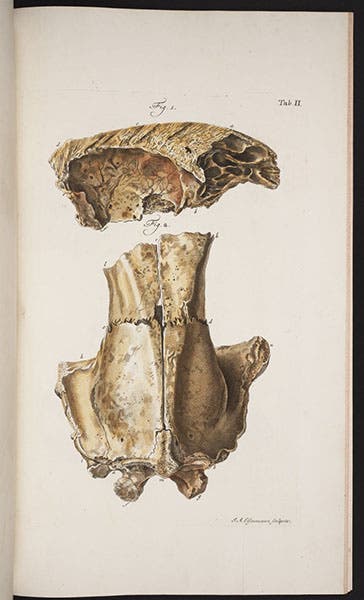Scientist of the Day - Johann Friederich Esper
Johann Friedrich Esper, a German physician, was born Oct. 6, 1732. In 1771, Esper investigated the Gailenreuth Cave, near Nuremberg in Bavaria, and he found the fossilized remains of quite a few animals no longer native to the region, such as hyenas, and lions. He also found the fossil bones of a large species of bear. The cave bear, Ursus spelaeus, was common throughout Europe during the Pleistocene epoch, but Esper was the first to discover its fossil remains. Esper also found, among the animal bones, a human jaw and shoulder blade, which led him to conclude that humans and extinct animals were contemporary creatures, a most uncommon idea at the time.
In a beautiful folio volume on his investigations, Description des zoolithes nouvellement decouvertes d'animaux quadrupedes inconnus et des cavernes (Description of Zooliths of Unknown Quadrupeds Newly Discovered in Caverns, 1774), Esper provided colored engravings of his cave bear fossils, but unfortunately, he did not illustrate the human remains, and they have never been located, so Esper lost his chance to be hailed as a discoverer of human antiquity. But he does have one other odd honor. One of the cave bear bones he studied, a femur, was deformed, and he correctly diagnosed the defect as the result of a bone cancer. Apparently this was the first successful attempt to diagnose a disease on the basis of a fossil, and so Esper is hailed in certain circles as the founder of paleopathology. In other words, he made possible the TV series Bones.
We have the first French edition of Esper's book (it was published simultaneously in 1774 in German and French) in our History of Science Collection. We reproduce here the engraving of a cave-bear jaw, with its formidable canines (which ought to be called ursines; first image); an engraved plate of a cave bear skull (third image); the title page of Esper’s book; and a detail of the engraving of the jaw (fourth image). We also include the uncolored engraved headpiece on page 1, which shows the Gailenreuth cave from the outside (second image).
One unexplained oddity about Esper’s Description des zoolithes is that the titlepage (fifth image) gives credit to George Wolfgang Knorr for the engravings. Knorr was indeed a noted Bavarian engraver whom we once featured in a post. But each engraving in Esper’s book is clearly signed by Jakob Andreas Eisenmann. I can find nothing about Eisenmann, even in German sources; perhaps he was a member of Knorr’s workshop. If any print historian can help us out here, that would be much appreciated.
Forty-five years after Esper, the noted English geologist and student of cave fossils, William Buckland, visited Gailenreuth (in 1816 and 1822); he described the cave in a paper in the Philosophical Transactions of the Royal Society of London (1822),and then in his Reliquiae diluvianae (1823), including an engraved cross-section of the Gailenreuth Cave that is quite striking. The engraving leads off our post of Buckland and you can see it there. The original drawing for the engraving, by Thomas Webster for Buckland, is in the archives of the Royal Society of London, and it is even more impressive. We show it here as our last image. One can make out what appear to be cave bear skulls in several locations in the multi-layered cave. I hope to write a post on Webster soon.
There is no portrait of Esper that I have located. If you search Google Images for Esper, you will find several, but those are of his brother Eugen, also a Bavarian naturalist. Why he rated a portrait and brother Johann did not, I do not know.
Dr. William B. Ashworth, Jr., Consultant for the History of Science, Linda Hall Library and Associate Professor emeritus, Department of History, University of Missouri-Kansas City. Comments or corrections are welcome; please direct to ashworthw@umkc.edu.











